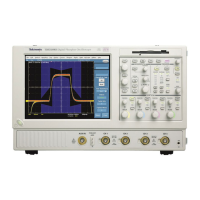95
High Impedance Probes
Most general-purpose probes have high input impedance. The high input resistance of passive
probes (typically 10 MΩ) provides negligible DC loading and provides accurate DC amplitude
measurements. Most passive probes require the instrument input impedance to be 1 MΩ.
However, their 8 pF to 12 pF (over 60 pF for 1X) capacitive loading can distort timing and phase
measurements. Use high resistance passive probes for measurements involving the following:
Device characterization (above 15 V, thermal drift applications)
Maximum amplitude sensitivity using 1 X probe
Large voltage range (between 15 V and 500 V)
Qualitative or go/no-go measurements
Low Impedance Probes
Most low impedance (Zo) passive probes measure frequencies or timing measurements more
accurately than general-purpose probes, but they take less accurate amplitude measurements. They
offer a higher bandwidth to cost ratio.
The low input impedance passive probes must be terminated in a 50 Ω instrument input. Input
capacitance is much lower than high impedance passive probes, typically 1 pF, but input resistance
is also lower (500 Ω to 5000 Ω typically). Although that DC loading degrades amplitude accuracy,
the lower input capacitance reduces high frequency loading to the circuit under test. That makes
low input impedance passive probes ideal for timing and phase measurements when amplitude
accuracy is not a major concern. Low input passive impedance probes are useful for measurements
up to 40 V.
Active Probes
Active voltage probes often contain preamplifiers that provide high resistance and low capacitance
at the probe tip. Some active voltage probes contain differential amplifiers that provide high
Common Mode Rejection Ratio (CMRR).
Active current probes often contain Hall-effect sensors that extend the probe bandwidth down to
DC.
Many active probes, especially high frequency probes, can drive a 50 Ω instrument input.
Probe Calibration Restrictions
Some probes cannot be calibrated or compensated. This might be because the probes have an
attenuation factor greater than 20X. You will get an error message if you try to compensate such a
probe.
The instrument cannot compensate for probes that may have gain and/or offset errors that are too
great (>2% or >50 mV offset). If these errors are within the specified limits of your probe, you
may want to use another probe. If the errors are outside the limits, have your probe checked by
service personnel.
Probe calibration is not recommended for the P5050 passive probe. This probe typically has little
gain and offset error, and therefore, the performance improvement after a probe calibration is not
worth the time needed to do the probe calibration.

